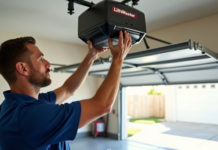Your home’s siding does more than enhance curb appeal—it’s your first line of defense against the elements. Whether you have vinyl, wood, fiber cement, or metal siding, proper care is essential to extend its lifespan and prevent costly repairs.
In this guide, you’ll discover expert siding maintenance tips that help protect your investment, maintain property value, and keep your exterior looking great year-round.
Why Siding Maintenance Is Important
Siding protects your home from moisture, wind, pests, and UV rays. When neglected, it can crack, rot, fade, or warp—leading to expensive problems like water damage or insulation failure.
Regular siding care helps preserve structural integrity, energy efficiency, and visual appeal. It also helps you avoid premature siding replacement.
Identify Your Siding Type
The first step in proper siding maintenance is knowing your siding material. Each type has unique care needs:
- Vinyl siding: Low-maintenance, but benefits from seasonal cleaning
- Wood siding: Requires sealing, staining, and regular moisture protection
- Fiber cement siding: Durable and fire-resistant, may need repainting
- Metal siding: Pest-resistant, but susceptible to rust without upkeep
If you’re unsure about your siding type or how to maintain it, a qualified siding contractor Bellingham can inspect and offer expert guidance.
1. Clean Your Siding Regularly
Over time, siding collects dirt, mold, mildew, and algae. Dirty siding not only looks unsightly—it can degrade the material.
Here’s how to safely clean siding:
- Use a garden hose and soft-bristle brush
- Apply mild soap or a siding-safe cleaner
- Rinse thoroughly
- Avoid pressure washers unless approved by the manufacturer
Clean your siding at least twice a year—ideally in spring and fall. This simple routine can add years to its lifespan. For step-by-step guidance, check out our siding cleaning guide.
2. Inspect for Damage
Conduct a visual inspection of your siding at least twice a year. Look for:
- Cracks or holes
- Warping or buckling
- Loose or missing panels
- Peeling paint or fading
- Mold or mildew stains
Identifying issues early helps prevent moisture infiltration and expensive structural repairs. If you spot damage, consult a trusted siding company Bellingham for professional assessment and repair.
3. Repair or Replace Damaged Panels Promptly
Small siding issues can quickly become big problems. Address them early:
- Replace cracked or broken vinyl panels
- Sand and reseal damaged wood
- Repaint fiber cement siding as needed
- Treat and patch rust on metal siding
If you’re unsure how to proceed, an experienced siding contractor Bellingham can recommend effective, affordable solutions.
4. Prevent Moisture Issues
Moisture is one of siding’s biggest threats. Keep it at bay by:
- Cleaning gutters and downspouts regularly
- Ensuring water drains away from your foundation
- Trimming back trees and shrubs
- Sealing any cracks or gaps
- Reapplying paint or sealant every few years
Good drainage and ventilation prevent mold growth, rot, and material breakdown.
5. Keep Pests Away
Wood siding is especially vulnerable to termites, carpenter ants, and birds. Here’s how to protect your home:
- Seal all openings with weatherproof caulk
- Inspect for chew marks or insect nests
- Keep vegetation away from siding
- Use pest deterrents or treatments when needed
A pest problem can quickly turn into a structural issue—early prevention is key.
6. Repaint or Restain When Needed
Painted siding fades over time, especially on sun-exposed walls. Repainting or restaining every 5–10 years:
- Protects against moisture and sun damage
- Restores color and finish
- Boosts curb appeal
Before painting, clean thoroughly, repair damage, and use high-quality exterior paint or stain. See our full exterior painting guide for expert tips.
7. Maintain Caulking and Seals
Caulk around windows, doors, and joints can crack or shrink over time. Inspect and reapply as needed:
- Remove deteriorated caulk
- Apply fresh, waterproof caulk
- Smooth with a caulk tool or damp finger
Well-maintained seals keep out water, pests, and drafts.
8. Watch for Fading and Warping
Faded siding is mostly cosmetic, but warping often signals deeper issues like moisture buildup or poor installation.
If you notice:
- Bowed or bulging panels
- Discoloration or chalky residue
- Cracked or brittle sections
Schedule an inspection with a trusted siding company Bellingham for a professional opinion.
9. Schedule Annual Professional Inspections
Even if you’re diligent with DIY maintenance, a yearly inspection from a licensed siding contractor Bellingham ensures nothing goes unnoticed. Professionals can:
- Detect hidden damage
- Identify moisture or pest issues
- Recommend maintenance or upgrades
It’s a smart, preventative step that could save thousands in future repairs.
10. Know When It’s Time for Siding Replacement
No siding lasts forever. Signs you may need replacement include:
- Frequent repairs
- Persistent drafts or higher energy bills
- Severe cracking, rot, or mold
- Water stains on interior walls
A modern siding upgrade can improve insulation, reduce maintenance, and enhance resale value. Visit our siding replacement cost guide for helpful budgeting tips.
Final Thoughts
Taking care of your siding is one of the smartest ways to protect your home’s exterior. With these siding maintenance tips, you’ll prevent damage, extend the life of your materials, and keep your home looking its best.
If you need seasonal cleaning, repairs, or a full inspection, don’t hesitate to contact a professional siding contractor Bellingham. For trusted expertise and long-term solutions, reach out to a reliable siding company Bellingham today.




